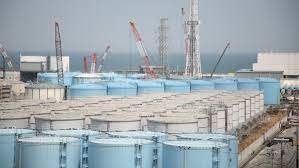The tsunami-wrecked Fukushima Daiichi nuclear power plant’s operator says it began releasing its first batch of treated radioactive water into the Pacific Ocean on Thursday — a controversial step that prompted China to ban seafood from Japan.
In a live video from a control room at the plant, Tokyo Electric Power Company Holdings showed a staff member turn on a seawater pump with a click of a mouse, marking the beginning of the controversial project that is expected to last for decades.
“Seawater Pump A activated,” the main operator said, confirming the release was underway. TEPCO later confirmed that the seawater pump was activated at 1:03 p.m. (0403 GMT), three minutes after the final step began.
TEPCO said an additional wastewater release pump was activated 20 minutes after the first. Plant officials said everything was moving smoothly so far.
Japanese fisher groups have opposed the plan for fear it will further damage the reputation of their seafood. Groups in China and South Korea have also raised concerns, making it a political and diplomatic issue.
In response to the release, Chinese customs authorities banned seafood from Japan, customs authorities announced Thursday.
The ban started immediately and will affect all imports of “aquatic products” including seafood, according to the notice. Authorities said they will “dynamically adjust relevant regulatory measures as appropriate to prevent the risks of nuclear-contaminated water discharge to the health and food safety of our country.”
But the Japanese government and TEPCO say the water must be released to make room for the plant’s decommissioning and to prevent accidental leaks. They say the treatment and dilution will make the wastewater safer than international standards and its environmental impact will be negligibly small.
Tony Hooker, director of the Center for Radiation Research, Education, and Innovation at the University of Adelaide, said the water released from the Fukushima plant is safe.
“It certainly is well below the World Health Organization drinking water guidelines,” he said. “It’s safe.”
“It’s a very political issue of disposing radiation into the sea,” he said. “I understand people’s concerns and that’s because we as scientists have not explained it in a very good way, and we need to do more education.”
Still, some scientists say the long-term impact of the low-dose radioactivity that remains in the water needs attention.
In a statement Thursday, International Atomic Energy Agency Director General Rafael Mariano Grossi said: “IAEA experts are there on the ground to serve as the eyes of the international community and ensure that the discharge is being carried out as planned consistent with IAEA safety standards.”
The United Nations agency also said it would launch a webpage to provide live data about the discharge, and repeated its assurance that the IAEA would have an on-site presence for the duration of the release.
The water release begins more than 12 years after the March 2011 nuclear meltdowns, caused by a massive earthquake and tsunami. It marks a milestone for the plant’s battle with an ever-growing radioactive water stockpile that TEPCO and the government say has hampered the daunting task of removing the fatally toxic melted debris from the reactors.
The pump activated Thursday afternoon sent the first batch of the diluted, treated water from a mixing pool to a secondary pool 10 minutes later. It then moves through a connected undersea tunnel to go out 1 kilometer (0.6 miles) off the coast. Officials said the water moves at a walking speed and will take about 30 minutes to exit from the tunnel.
The operator checked data and the progress on a set of four monitors that showed the water volume, pump conditions and any alerts.
TEPCO executive Junichi Matsumoto said Thursday’s release was planned to start small in order to ensure safety.
The wastewater is collected and partly recycled as cooling water after treatment, with the rest stored in around 1,000 tanks, which are already filled to 98% of their 1.37-million-ton capacity. Those tanks, which cover much of the plant complex, must be freed up to build the new facilities needed for the decommissioning process, officials said.
Final preparation for the release began Tuesday, when just one ton of treated water was sent from a tank for dilution with 1,200 tons of seawater, and the mixture was kept in the primary pool for two days for final sampling to ensure safety, Matsumoto said. A batch of 460 tons was to be sent to the mixing pool on Thursday for the actual discharge.

 Iran Energy News Oil, Gas, Petrochemical and Energy Field Specialized Channel
Iran Energy News Oil, Gas, Petrochemical and Energy Field Specialized Channel



